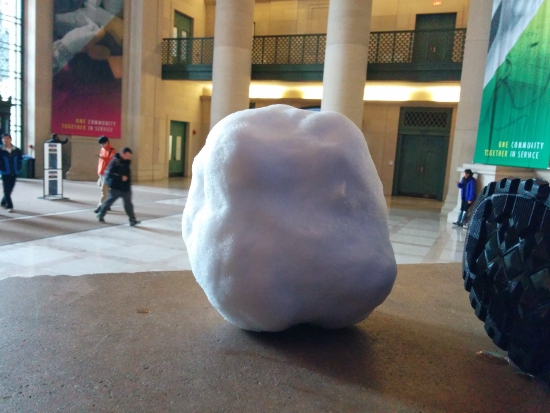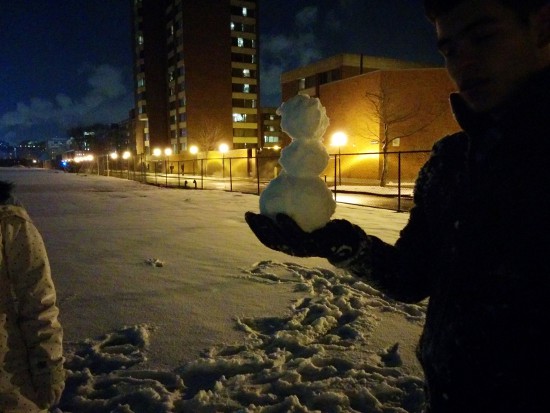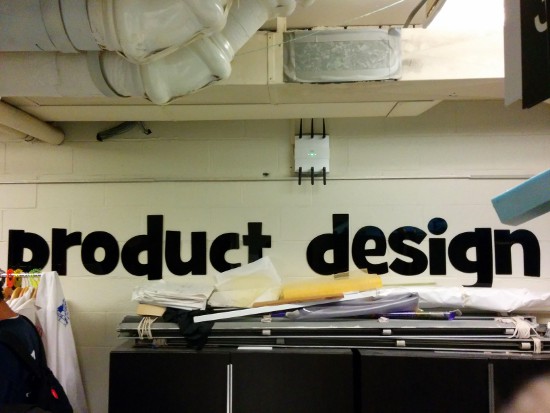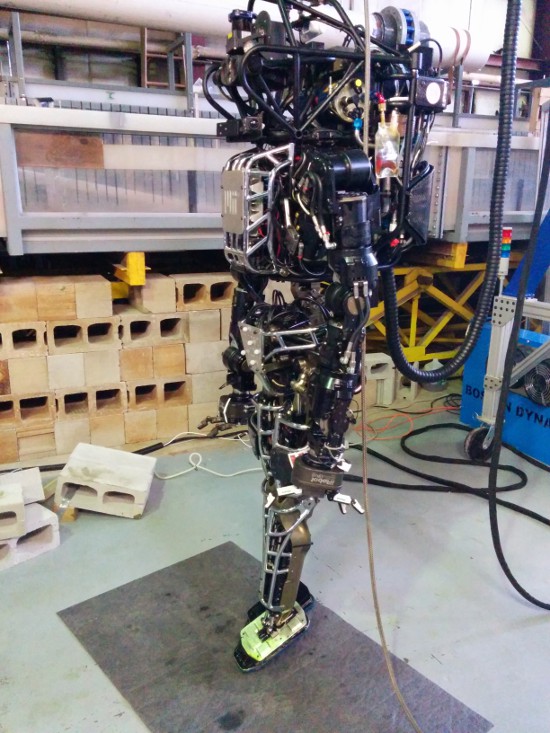Nearly a week ago, I sat in my living room packing warm clothing for my journey to Cambridge for the 2014 MIT THINK Scholars winner's trip. THINK is a competition for high school students whose only barrier to executing their bold ideas is a want for resources. My friend Gabe and I submitted a proposal for our project, Smart Windows for Dynamic Home Energy Optimization, which was selected as one of three winning proposals. Winners receive a grant from THINK to implement the project over the course of a semester, with mentorship from the MIT community. The purpose of our trip was to attend events and tours at MIT for exposure to scientific/academic/industrial processes, as well as meet with potential faculty mentors. In what have been some of the most thrilling, exciting, science-filled, snowy days of recent memory, I've derived from the THINK trip an incredible excitement and enthusiasm and hope for the future of not only the journey of implementation my project proposal faces, but the health of the communities of builders and makers I've encountered that exist in creativity-dense spaces.

My contribution to Lobby 7.
I. Exploration and Art
Arriving Sunday night, Gabe and I situated ourselves in Next House with our awesome hosts. We were totally struck by how friendly and energetic 3W was, and how well we were able to fit with the old and new friends we found at Next. The majority of the first night was unstructured time, and a great friend of mine was able to lead us around campus, wandering and exploring the small, intrinsically interesting spaces that really spoke to the unique character of the MIT campus. For example, the toy soldiers on a window sill of Building 36 (followed by my attempt to climb up to them), the binary index tree encoded floor tiles in 56, and a cool ellipsoid concrete bench setup that had awesome acoustics all were small things that captured my fascination and really cumulatively made my night. The most exhilarating thing I did, though, was go chairing. After (I guess) borrowing some rolly chairs from a nearby Athena cluster and heading to the edge of a ramp in the tunnels, we kicked off and discovered firsthand how physics and components of a due to g and stuff actually make you go really fast down an incline. Once I got over the initial surprise, the next step was to advance to the other hallway where the ramp has a turn; I suppose the strategy there was to kick off the wall with my legs at the bend and I'd like to say that's what happened, but it went down a little less gracefully, especially with someone rolling directly behind/beside me.
A quick aside. The first time I visited MIT I made some observations about the Sol LeWitt Bars of Color room by the DMSE. I've since then discovered this handwritten letter from Sol to fellow artist Eva Hesse. The sentiment of removing self-imposed bounds in the artistic process and allowing oneself to simply do, or create, is a necessary inspiration to me as someone who values trying new things and exploratory growth. Sol LeWitt's work also fascinates me for the fact that, as I found out from my tour guide at the University of Texas Computer Science competition (the day before I left for MIT), he envisions his pieces as an exercise in the transmission of ideas. The Circle with Towers guarding the entrance to the Gates-Dell Complex of UT was designed with instructions that allowed anyone with the physical means to construct the work. In a way, I feel like it can be thought of as an open-source artwork. The ways I relate spatially to Circle and Bars definitely warrant some interesting thoughts about the open interpretation of the art which follows.
II. Techfair, CSAIL, and Snow
Monday at MIT saw the excitement of the Techfair organized by THINK's parent organization, MIT TechX. Techfair is billed as a cross between a technology expo and a career fair; student projects (our undergrad counterparts) displayed the results of their hard work, and company representatives provided information to potential interns. Since I'm happily committed to Coursera for a summer internship through the KPCB Fellowship, I wasn't under any pressure in that respect; however, I loved learning about the impactful work the companies achieve. I'm especially interested in the potential for lowered barriers and therefore increased, democratized access to and proliferation of quality education that the recent edtech movement contains -- the educational space ties into my broader interest in how technology can shape the way humans interact with each other. I feel like for that reason I really enjoyed talking to Codecademy (I happened to be chatting up Ryan, the cofounder; how cool is that?) and Quizlet about their different approaches to learning. In the case of Codecademy, they're at an exciting stage where they're trying to develop metrics to measure ability to learn rather than existing knowledge, which makes them valuable in a recruitment capacity as well as an educational one. For Quizlet, I was totally surprised to learn that they only have 7 engineers, which is crazy for a site of their scale. It's so amazing and exciting to me to see a company at that critical period where right now every bit of work they do matters and shapes their future. Pretty soon they'll likely start growing out their ninja hacker team and that'll be a sight to behold as the "small company" dynamic shifts.

After Techfair, we got the chance to meet with Prof. Sam Madden to discuss our project. He gave us some really solid feedback and advice on the physical design of our sensor system, as well as some potential corner cases and future possibilities for growth in our project. It was also incredibly fascinating to hear about his research work with sensor networks in cars to tackle traffic and automotive data concerns. In Gabe and my ideation process before we settled on a project to propose, we would watch TED Talks together after school and we at one point contemplated potential solutions to traffic control problems. Since Prof. Madden is also a database expert, we also had fruitful discussion on the subject of database trends, since my work last summer with Azul at UT Austin involved much experimentation with NoSQL and relatively new database technologies and paradigms. Interestingly enough, I was previously aware of some of Prof. Madden's work due to some of his Quora answers -- it turns out he used to work with one of the early Quora team. I was definitely grateful for his time and appreciated how well his interests intersected with ours.

On the first day I pointed at a little mound of ice and asked if it was snow; my climate-based culture shock continued Monday night when we got legitimate snow in which to frolic and play. At night, I called my friends down from Next House (who are awesome for agreeing spontaneously to play with snow because yes) and we hopped a fence to a field full of white fluffy magic. The four of us built a wimpy snowman while talking about coding problems and had an epic snowball fight that could have been a little more epic; I can honestly say that I was having one of the greatest times, enjoying time with great people and being playful without worrying about anything at all.
III. Awesome Labs, Deep Conversation
If I ever thought I couldn't get more excited about the sciencey happenings at MIT, I was quickly proven wrong by our lab tours on Tuesday. Our first stop was the Nuclear Reactor Lab, and it was quite the sight to behold. The intricacies of the system at such a huge scale, as well as the attention to detail involved in running the reactor, made quite the impression. We had to check ourselves for radiation contamination on the way out. I found it funny that there were two dosimeter stations within a couple feet of each other down the hall. Our tour guide said he had never heard of anyone getting contaminated between one and the other, but we had to check ourselves on both. In direct contrast to the Safety Third mantra of Next House 3W, we erred on the side of caution.
The most I ever felt in my element on a tour was during our looks at the Game Lab and the Media Lab. As I mentioned previously, a big point of interest to me is the intersection of technology and human interaction. It was then extremely exciting for me to hear about the research the Game Lab does into, for example, how games motivate people, how it shapes the social interactions between people, and how they present narratives the interpretation of which belongs to the player in the same way literature belongs to its reader. I had heard of Game Lab previously due to their Slower Speed of Light project, but after the meeting I was completely sold on their aspect of Comparative Media Studies at MIT. I love how insightful something like research into creative play can be into human behavior.
We then visited the Lifelong Kindergarten group at MIT Media Lab. The group is sponsored by LEGO, and when I say you could tell by looking, I mean that as a high complement. There was a clear table shaped like a LEGO brick. Inside the brick were more LEGO bricks. It was so meta even this allusion. We discussed at length projects like Scratch, MaKey MaKey, and DressCode that use creative play to facilitate hands on learning, design, and even fabrication. Incidentally, I'd heard of MaKey MaKey through their Kickstarter but never realized they originated from Media Lab. I had also, never having seen one, assumed they were capacitative sensing when they were actually resistive, which I found interesting from a circuit design perspective. I don't think I was ever so excited about what we were discussing at any other point on the trip. When I got back to Next House that day, some of my friends can probably testify to the excited arm-flailing effusive outburst I had about Media Lab.

"Every object tells a story if you know how to read it."
Our last tour for the day was the Product Design Lab, and much can be said for the value and satisfaction of making things with your own hands. I've loved thinking about product design ever since a friend introduced me to the documentary Objectified, and the conversation we had there was very much in alignment with that mode of thought. Our guide was kind enough to design and prepare materials to fabricate refrigerator magnets of our names, and we got to see the laser cutter in action. Interestingly enough (and somewhat embarrassingly), she let me use calipers to measure the thickness of the material to cut. At first I had to ask how to use calipers (not how to read the digital output, mind you, but actually where do I hold this), and then I didn't see the decimal point and called out a reading of 9 inches rather than 0.09 inches. Hopefully my willingness to learn redeems my derpiness in that case; please don't revoke my science license.
When we arrived back at Next House, we were lucky enough to witness the crazy/hilarious birthday tradition of the house. As we celebrated a birthday at midnight with everybody, my friend kept warning Gabe and I to back away. I wasn't really sure why, until suddenly I heard someone shout "Get him!" and a bunch of people started running to catch and drag the birthday boy into the shower with his clothes on. The rules of showering and countershowering on birthdays were explained to me to my amusement.
We slept really late that night; first, Gabe engaged our host in a spontaneous game of ping-pong. The conversation went something like:
"Hey, so when are we going to play?"
"Oh, right now. But actually."
The spontaneity lasted while we conversed about interests in sustainable energy and solving big, seemingly intractable problems at the global scale. Our conversation lasted well into the night and touched on many subjects, including a critique of the corporate culture espoused by the Techfair, in direct odds of that idealistic drive to use our talents to impact the world positively in ways that are important. It seems like that would be an unpopular opinion and it was really cool that we not only all had a similar thought to a degree, but we were also able to discuss in depth what we felt that indicated about the event's priorities. What really struck me with our late night conversation is how easily accepted Gabe and I were and how much our interests and conversational topics aligned with our hosts.
By the way, if you think this post is long imagine how it must have felt to realize while I was typing this that all of these things happened on the same day. It's really amazing how awesome and dense my time at MIT was and I'm definitely grateful for everything and everyone that made it awesome.
IV. Robots, Denial, Failure of Snow to Cancel Correct Flight
Our second faculty meeting Wednesday morning was with Prof. Dennis Freeman. I was especially interested to hear his thoughts from the perspective of an educator on methods of propagating good education. He told us about how he worked on developing the 6.01 syllabus to unite the EE and CS aspects of Course 6 with practical, hands-on purpose in order to provide a better educational experience for people taking the introductory course. Indeed, one of the things that initially attracted me to MIT's EECS department is their treatment of the two different perspectives as different layers of abstraction on the same fundamental ideas.

MIT's Atlas. I tried a joke about the robot shrugging; it wasn't funny.
For our last structured activity, we were scheduled to visit the Robot Locomotion group at CSAIL. Unfortunately due to the snow our group's contact wasn't there, but way fortunately for us was that someone who happened to be there was willing to give us a tour anyway. I was appreciative of how CSAIL had to have been the friendliest group, and they weren't even expecting us. We got to see different, awesome developments in robotic locomotion, and discuss their approach for the DARPA Robotics Challenge. I also really enjoyed seeing a project that autonomously navigates through forests by sensing and dodging trees on the fly. We capped off the tour by visiting the super awesome Atlas robot built by Boston Dynamics for MIT's DARPA Challenge entry. I can't even begin to imagine the complexity of the hardware and software systems that control that robot.
With the snowstorm that hit on Wednesday, our original flight home was preemptively canceled. We were exploring the option of leaving later or staying an extra day. Truth be told, Gabe and I were in total denial that our trip was coming to an end, hoping that our new same-day flight would too be canceled. Realistically, though, we went home knowing that we had a great time, more so than we could've ever expected, and that we were only at the beginning of the journey regarding project implementation in the coming semester.
I'm glad I was able to relate these memories here and while I expect this to end up as one of my longest posts, it's only because so many exciting things happened on the trip. I hope I've also potentially given future THINK Scholars a better idea of what to expect from their journey. (I suppose the tl;dr version is: you will make friends and see cool things and get excited about science so get ready.) I won't easily forget how great it felt to be surrounded by a creative, innovative, idiosyncratic culture that supports the kind of student endeavors that align with solving interesting problems, and will definitely take what I've learned and experienced with me as I continue my scientific pursuit.